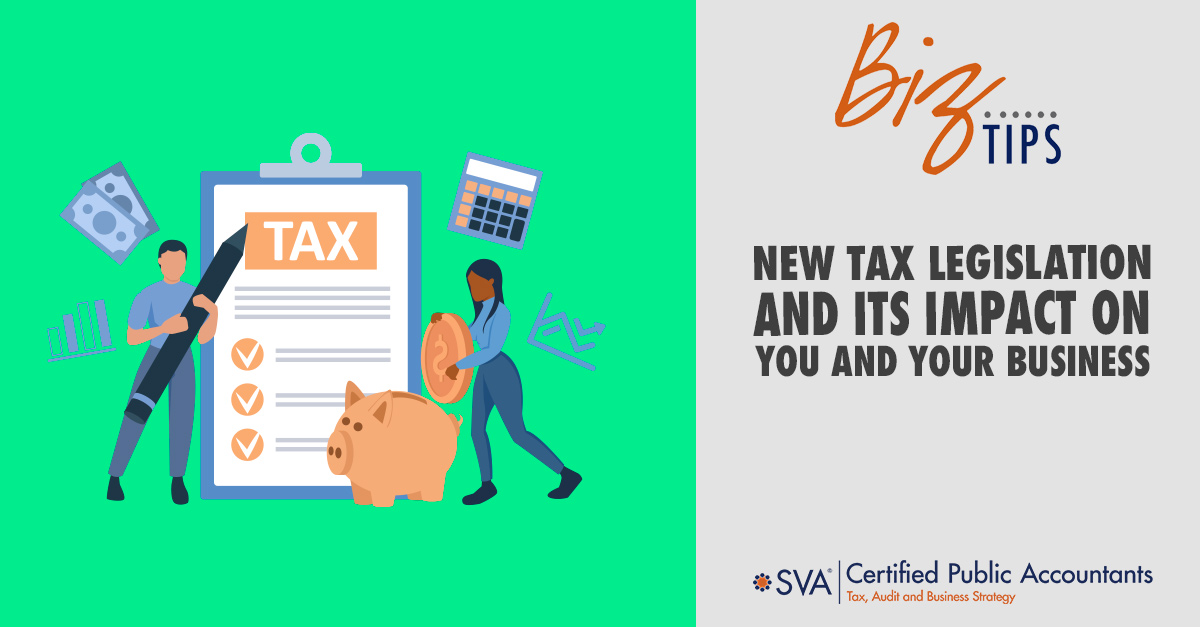

Published on: Dec 30, 2022 by Eric Trost, CPA, MST
Updated on: March 14, 2025
The Infrastructure Investment and Jobs Act (IIJA) is now law, and the Build Back Better Act (BBBA) is potentially on the horizon. Plus, the IRS recently announced the 2022 cost-of-living adjustment amounts. With year-end fast approaching, it’s imperative you understand the new legislation and its impact on you and your business.
There are numerous proposed tax law changes that will impact businesses as well as individuals. Most notable are as follows:
RELATED CONTENT: BIZ TIP
DON'T FORGET TO FACTOR 2022 COST-OF-LIVING ADJUSTMENTS INTO YOUR YEAR-END TAX PLANNING
The Build Back Better Act is a bill introduced in Congress to fulfill aspects of President Joe Biden's Build Back Better Plan. It was spun off from the American Jobs Plan, alongside the Infrastructure Investment and Jobs Act. The bill was passed by the House on November 19, 2021 and is expected to receive a formal Senate vote in January 2022.
Proposed Tax Increases
There are some tax increases in the Build Back Better Act but they are much slimmer than what was originally proposed.
In the Build Back Better Act tax proposals, business trusts get hit hard with these increases. If there is a business within a trust, the 5% tax (which kicks in for individuals at $10 million) applies for the trust at $200,000. The additional 3% tax (that kicks in for individuals over $25 million of income) kicks in at $500,000 for the trust. There is also the 3.8% net investment income tax on business income. If this would pass, there might be a suggestion on restructuring your business if it's owned by a trust. These trusts are going to pay much higher taxes than if it was simply owned by individuals or at least taxed to the individuals.
Proposed Tax Decreases
There are a few proposed tax decreases within the Build Back Better Act:
What Was Left Out?
The items that are no longer included in the Build Back Better Act are fairly significant compared to what was originally proposed.
RELATED CONTENT: TAX E-ALERT
LOOKING FOR A 2022 SAFETY NET FOR YOUR BUSINESS? ACT ON EIDL FUNDING BEFORE YEAR END
Signed into law on November 15, 2021, the Infrastructure Investment and Jobs Act is not a tax bill per se, but there are some tax items within the bill to be aware of. The most significant item in the bill is the ending of the Employee Retention Credit (ERC). The third quarter of 2021 is the last quarter that employers are able to apply for the ERC and receive those benefits.
Cryptoasset reporting is also included in the bill. Beginning January 1, 2023, brokers will be required to disclose to the government any transfer of digital assets into accounts.
Other minor tax provisions included are automatic extensions in the disaster areas, extension of various highway-related taxes, and reinstatement of certain superfund excise taxes (for example, hazardous substance superfund tax on chemical manufacturing and imports).
The Employee Retention Credit (ERC) is a valuable tax break that was enacted to encourage employers to hire and retain employees during the pandemic. The ERC is a refundable tax credit against certain employee wages and employment taxes if you had a government shutdown or a decline in receipts in 2021 or 2020 when compared to the same quarter in 2019. Eligible wages depend on the number of full-time employees (FTEs), but owner and related-party wages are not eligible for the credit. Eligible employers can claim the refundable ERC against applicable employment taxes equal to 70% of the qualified wages the business pays.
Originally, a business that received a PPP loan was not eligible to receive the ERC. In January 2021, the IRS retroactivity allows employers who received the PPP loan to claim the ERC for qualifying wages that are not treated as payroll costs in obtaining PPP loan forgiveness.
To qualify for the Employee Retention Credit in 2020, a company needed a 50% decline in gross receipts during any quarter in 2020 compared to that same quarter in 2019. A business could also qualify if they experienced a full or partial government shutdown.
In 2021, a business needed a 20% decline in gross receipts during any quarter in 2021 relative to that same quarter in 2019. Again, a company could also qualify if they experienced a full or partial government shutdown.
The eligible wages that qualify for the Employee Retention Credit are dependent on the number of full-time employees in the business.
How much of a credit can a business actually receive?
In 2020, the credit is capped at $5,000 per year, per employee (this is a 50% tax credit up to $10,000 of wages). In 2021, it is $7,000 per quarter, per employee credit (this is a 70% tax credit up to $10,000 of wages). It is a quarter maximum, so you could feasibly save $28,000 per employee, per year if you had 80% or less in receipts when comparing each quarter with the corresponding quarter in 2019.
A business cannot use the same wages for the PPP and the ERC. For the PPP, you must use at least 60% or more for wages, but you could use up to 40% for expenses such as employer portion of health insurance benefits, mortgage interest, rent, utilities, workforce training, and COVID-related expenses relating to supplies, equipment, and technology (e.g., sanitizers, air purification systems, HVAC systems, etc.).
It’s important to note that the PPP loan is based on 2.5 months of payroll wages and the forgiveness period is based on 5.5 months (24 weeks). So if you do qualify for the ERC, you should have plenty of wages available for the PPP as well as the ERC.
In the state of Wisconsin, there was a bracket reduction for individual taxes for 2021. The tax bracket rate was adjusted from 6.27% down to 5.3% for income between $32,330 and $355,910. For married couples earning over $355,000, this could produce a tax reduction of approximately $3,000. For single individuals earning over $260,000, this would amount to about a $2,000 savings. This reduction in rates can also affect a business’s entity tax election in regards to pass-through income. Other states may have other adjustments and opportunities to take an entity level tax election if you're a business owner with pass-through income.
There was also a 5.1% cost of living increase for 2022. There is a greater opportunity to defer more money into 401(k) accounts but there may be some deduction limitations.
Be prepared to make some quick moves that can affect your tax liabilities if the Build Back Better Act is passed. Know where your 2021 income is at because the net investment income tax could affect businesses going forward so you may want to recognize a bit more income in 2021 versus 2022.
Continue to follow SVA. As the Senate resumes discussions on the Build Back Better Act in January, SVA will keep you updated on all the latest information. Keep informed by signing up for SVA’s Tax eAlerts today!
© 2021 SVA Certified Public Accountants
Share this post:

Eric is a Principal with SVA Certified Public Accountants with vast experience and technical knowledge in tax compliance, research, and planning. He assists corporations and partnerships with tax savings through transaction structuring, tax credits and accounting methodology. He works closely with businesses to plan their cash flow for tax liabilities through quarterly estimate planning.
Get Weekly Biz Tips Delivered Straight to Your Inbox!
Services
Madison, WI
1221 John Q Hammons Dr, Suite 100
Madison, WI 53717
(608) 831-8181
Milwaukee, WI
18650 W. Corporate Drive, Suite 200
Brookfield, WI 53045
(262) 641-6888
Colorado Springs, CO
10855 Hidden Pool Heights, Suite 340
Colorado Springs, CO 80908
(719) 413-5551

Are you in the know on the latest business trends, tips, strategies, and tax implications? SVA’s Biz Tips are quick reads on timely information sent to you as soon as they are published.
Copyright © 2026 SVA Certified Public Accountants | Privacy Policy | Cookie Policy | CCPA